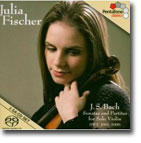Music |
Julia Fischer
By
Published: May 20, 2009
Category:
Classical
This is the age of the phenomenon, of unknowns rising like rockets and lighting up the sky until they’re all we can see. But only briefly. Then they plummet to earth — moments older, millions richer. Career? Don’t even dream about it. Longevity is so 20th Century. This is the age of the phenomenon.
Of all the arts, the traditional forms are the exception. Opera, ballet, classical music — success is one part talent, many parts training. Still, every few years, a few young musicians are launched as if they’re rock stars. And, in a way, they are: beautiful young women in figure-revealing gowns playing pieces so difficult they’re avoided by masters twice their age.
Julia Fischer is the queen of the new crop of camera-friendly violinists. Born in 1983, she was a concert soloist well before her 20th birthday. At 20, she made her Carnegie Hall debut — the Brahms Double concerto, conducted by Lorin Maazel and accompanied by the Bavarian Radio Symphony Orchestra. When she was finished, the audience rose to cheer.
And then, at 21, she decided to record Bach sonatas and partitas.
The line on Bach is that this is holy music, written from a place so deep that it should only be attempted by musicians with decades of life behind them. Bach’s like Everest; you have to earn the right to be there. Where does a youngster — a girl, if you will — get the nerve? And why would a record company take the project on, except as a kind of circus trick?
I’ve been living for a while with Julia Fischer’s two-CD set of Bach sonatas and partitas, and although my ears are not up to every nuance, I had no trouble grasping this — Julia Fischer’s age is a non-event.
For one thing, she’s spent her life with Bach. Although she started studying violin at 3, she waited until 7 to play Bach, and then on piano. At 9, Bach’s music for violin became her steady companion: “My day has to begin with Bach, and I find it very difficult to concentrate on the music of another composer before having ‘cleansed myself’, as it were, with Bach.”
But recording at 21? “Patience has never been my strong point,” she says. “And I have waited a number of years for an opportunity to record these works.” After all, it’s not as if she had never performed Bach sonatas and partitas in public — in 2000, when she was 17, she played both cycles at a major German festival.
Fischer records on a label that produces “super audio CD.” It builds much of its own recording equipment; its obsession is “the analogue signal path.” Translation: You hear just two things — music and silence.
That recording technique couldn’t be better for a violinist like Julia Fischer, who does not so much play the music as live it. Really, her merger with Bach is so complete that it’s as if he’s writing and playing through her — thinking the notes out here, deciding to end a phrase there. Heard this way, Bach is exciting: serious, but not solemn, vibrantly alive. Early on, you’re convinced you can go as deep as the composer wants to take you.
Bach as philosopher and spiritual guide — that’s one rewarding way to listen to this recording. Another way is just to wallow in the beauty. Fischer’s approach to Bach, though influenced by Glenn Gould, thankfully avoids his original interpretations. Her playing doesn’t break ground; it’s simply better than you’d think possible. And in every way. She swoops, bites, breathes, soars. She’s beyond self-confident; she’s completely in charge.
For 73 minutes, I gave myself over to music’s greatest composer and his latest champion. Surrender was never so pleasant.
To buy Fischer playing J.S. Bach: Sonatas and Partitas for Solo Violin from Amazon.com, click here.
To buy Fischer playing Mozart: Violin Concertos from Amazon.com, click here.
To buy Fischer playing Mozart, W.A.: Violin Concertos Nos. 1, 2 & 5 from Amazon.com, click here.
To buy Fischer playing Brahms: Violin Concerto and Double Concerto from Amazon.com, click here.
For Julia Fischer’s web site, click here.


